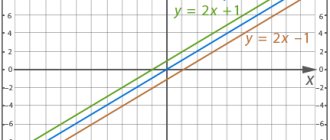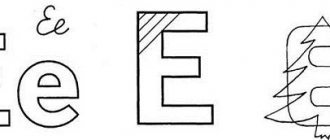Quadratic function, its properties and graph
Prokhazhaeva Elena Gennadievna
MKOU Kachugskaya secondary school No. 1
Algebra 8th grade textbook authors
Sh.A. Alimov and others.
topic “Quadratic function, its properties and graph”
lesson duration 40 minutes.
Type of lesson
– Lesson of generalization and systematization of the studied material
Forms of student work
– collective, in pairs, independent work
Lesson objectives:
Summarize and systematize skills and abilities on the topic “Quadratic function”. Develop UUD.
Regulatory -
goal setting, planning, control and evaluation of one’s actions.
Cognitive
— systematize information in accordance with given indicators, highlight the main idea, establish connections between objects, reflection.
Communication
- ability to interact with peers when working in a group, enter into dialogue, collaborate productively
Personal
- formation of determination and perseverance in achieving your goals
During the classes
1. Organizational moment.
Hello guys! I want to start the lesson with the words of the French scientist R. Descartes “Mathematics teaches you to overcome difficulties and correct your own mistakes”
And I would like you to overcome all your difficulties in the lesson and successfully write s/r.
2. Update
1) So, what topic do you think the s/r will be on?
Planned answer: on the topic “Quadratic function”
2) To write it successfully, what needs to be done?
Planned answer: Repeat theory and practice on this topic
3) What goals will we set for ourselves?
Planned answer: Repeat the definition of a quadratic function, types of functions depending on the coefficients, properties of the function, its graph, solve problems.
The class is divided into groups, each is given a route sheet, and group leaders are appointed. Working in groups, students generalize and systematize the topic “Quadratic functions”
3. Work in groups (students are divided into 3 groups and leaders are appointed separately)
1. Guess what function we are talking about. The “Yes-no” pedagogical technique is used, which develops the ability to connect disparate facts into a single picture, the ability to systematize existing information. The group leader (student) thinks of a quadratic function. Students try to find the answer by asking questions that the group leader can only answer with “yes,” “no,” and “yes and no.” As a result of the work, the leader puts a mark on the route sheet for each student.
2. Repeat the properties of the function and view its graph. The “Thought Clouds” technique is used, which develops the ability to systematize information in accordance with given indicators. Students report everything they know about a given function, and as the theory is repeated, the group collectively draws up a summary plan. The “Own Support” technique, which develops the ability to highlight main thoughts, the ability to establish connections between objects, and present information in a “collapsed form”
3. Solving typical tasks on this topic. Students solve, check each other's assignments (construct a graph of a function, write down the properties of a function, find the vertex of a parabola, the points of intersection with axes), and explain unclear points to each other. The “Learning Together” technique is used, which develops the ability to work in pairs and groups.
4. Students complete individual written assignments based on options.
№1 (technique “Dictation of values”)
Write the general form of a function whose coefficients
| Option 1 | Option 2 |
| a is equal to 1, b=c=0 Planned answer y = x2 | a is not equal to 0, b is not equal to 0, c is not equal to 0 Planned answer y = ax2 + inx + c |
№2
Find the coordinates of the points of intersection of the parabola with the coordinate axes
| Option 1 | Option2 |
| a) y = –2x2 – 8x + 10 With Oy axis: x = 0; y = 10; (0; 10); With the Ox axis: y = 0; –2×2 – 8x + 10 = 0; x2 + 4x – 5 = 0; x1 = –5; x” = 1; (-50); (1; 0) – points of intersection. Answer: (0; 10) point of intersection. with Oy axis; (-50); (1; 0) – points of intersection with the Ox axis. | b) y = 7x2 + 14; With Oy axis: x = 0; y = 14; (0;14); With the Ox axis: y = 0; 7×2 + 14 = 0; x2 + 2 = 0; There are no roots. Answer: (0;14) – point of intersection with the Oy axis; It does not intersect with the Ox axis. |
№3 Establish a correspondence between the graphs of functions and the formulas that define them.
The material is taken from training versions of examination papers for the State Examination Test 2014 in a new form. Publishing house AST Astrel Moscow
5. Summing up (self-test (based on the decision on the back of the board) Self-assessment according to the criteria posted on the board, putting a grade on the route sheet, deducing the total for work in groups and for s/r, identifying typical errors and gaps in knowledge and skills, as well as ways to eliminate and improve them).
5. Setting homework assignments. Reflection.
Parity and symmetry of a quadratic function
Symmetry about the ordinate axis
The graph of the function f ( x ) = x 2 {\displaystyle f(x)=x^{2}} ( b = 0 {\displaystyle b=0} and c = 0 {\displaystyle c=0} ) is symmetrical about the ordinate
The quadratic function f ( x ) = ax 2 + bx + c {\displaystyle f(x)=ax^{2}+bx+c} is an entire rational function of the second degree, therefore all the corresponding properties of an entire rational function are valid for it. In particular, it is even only if the notation of its polynomial contains only even exponents, and odd - if it contains only odd exponents. It follows from this that no quadratic function can be odd due to the fact that the condition a ≠ 0 {\displaystyle a\neq 0} is initially imposed on it, and therefore it will always contain an even exponent 2.
In addition, it is obvious that a quadratic function is even only if there is no exponent 1, which means b = 0 {\displaystyle b=0} . This fact can be easily proven directly. Thus, it is obvious that the function f ( x ) = ax 2 + c {\displaystyle f(x)=ax^{2}+c} is even, since it is true:
f ( − x ) = a ⋅ ( − x ) 2 + c = ax 2 + c = f ( x ) {\displaystyle f(-x)=a\cdot (-x)^{2}+c=ax^ {2}+c=f(x)} , that is, f ( − x ) = f ( x ) {\displaystyle f(-x)=f(x)} .
Thus, a quadratic function is symmetric about the y-axis only when b = 0 {\displaystyle b=0} . The specific values of the coefficients a {\displaystyle a} and c {\displaystyle c} do not affect this fact at all. In particular, c {\displaystyle c} can also be equal to zero, that is, absent from the formula. In this case, the vertex of the parabola will coincide with the origin of the coordinate system.
In all other cases, the quadratic function will be neither even nor odd, that is, it is a function of general form. This can also be easily shown using the definition of parity of a function:
f ( − x ) = a ⋅ ( − x ) 2 + b ⋅ ( − x ) + c = ax 2 − bx + c ≠ f ( x ) {\displaystyle f(-x)=a\cdot (-x) ^{2}+b\cdot (-x)+c=ax^{2}-bx+c\neq f(x)} , that is, f ( − x ) ≠ f ( x ) {\displaystyle f(- x)\neq f(x)} . f ( − x ) = a ⋅ ( − x ) 2 + b ⋅ ( − x ) + c = ax 2 − bx + c = − ( − ax 2 + bx − c ) ≠ − f ( x ) {\displaystyle f (-x)=a\cdot (-x)^{2}+b\cdot (-x)+c=ax^{2}-bx+c=-(-ax^{2}+bx-c) \neq -f(x)} , that is, f ( − x ) ≠ − f ( x ) {\displaystyle f(-x)\neq -f(x)} .
Axial symmetry in general
The axis of symmetry of any parabola is a straight line passing through its vertex parallel to the ordinate axis.
At the same time, the graph of any quadratic function has axial symmetry. As is known, if for some function f ( x ) {\displaystyle f(x)} for some number x 0 ∈ R {\displaystyle x_{0}\in \mathbb {R} } the equality f ( x 0 + x ) is true = f ( x 0 − x ) {\displaystyle f(x_{0}+x)=f(x_{0}-x)} , then the graph of this function f ( x ) {\displaystyle f(x)} has an axial symmetry with respect to the straight line x = x 0 {\displaystyle x=x_{0}} . In relation to a quadratic function, this number x 0 {\displaystyle x_{0}} is the abscissa of the vertex of its parabola. Thus, the graph of any quadratic function is symmetrical with respect to an axis parallel to the ordinate axis and passing through the vertex of the parabola, and the axis of symmetry of the function is f ( x ) = ax 2 + bx + c {\displaystyle f(x)=ax^{2} +bx+c} is the line x = − b / 2 a {\displaystyle x=-b/2a} .
The proof of this fact is also not difficult:
f ( x 0 + x ) = f ( x + x 0 ) = f ( x − b 2 a ) = a ( x − b 2 a ) 2 + b ( x − b 2 a ) + c {\displaystyle f( x_{0}+x)=f(x+x_{0})=f\left(x-{\frac {b}{2a}}\right)=a\left(x-{\frac {b} {2a}}\right)^{2}+b\left(x-{\frac {b}{2a}}\right)+c} = a ( x 2 − 2 ⋅ x ⋅ b 2 a + b 2 4 a 2 ) + b ( x − b 2 a ) + c {\displaystyle =a\left(x^{2}-2\cdot x\cdot {\frac {b}{2a}}+{\frac { b^{2}}{4a^{2}}}\right)+b\left(x-{\frac {b}{2a}}\right)+c} = ax 2 − bx + b 2 4 a + bx − b 2 2 a + c = ax 2 − b 2 4 a + c = ax 2 + 4 ac − b 2 4 a {\displaystyle =ax^{2}-bx+{\frac {b^{2} }{4a}}+bx-{\frac {b^{2}}{2a}}+c=ax^{2}-{\frac {b^{2}}{4a}}+c=ax^ {2}+{\frac {4ac-b^{2}}{4a}}}
The transformation leads to a similar result:
f ( x 0 − x ) = f ( − x + x 0 ) = f ( − x − b 2 a ) = ⋯ = ax 2 + 4 ac − b 2 4 a {\displaystyle f(x_{0}-x )=f(-x+x_{0})=f\left(-x-{\frac {b}{2a}}\right)=\dotsb =ax^{2}+{\frac {4ac-b ^{2}}{4a}}}
Thus, f ( − b 2 a + x ) = f ( − b 2 a − x ) {\displaystyle f\left({\frac {-b}{2a}}+x\right)=f\left( {\frac {-b}{2a}}-x\right)} , therefore the graph of the function is symmetrical with respect to the line x = − b 2 a {\displaystyle x={\frac {-b}{2a}}} .
Calculating the vertex of a parabola using function zeros
The zeros of the function are located symmetrically to the axis passing through the vertex of the parabola parallel to the ordinate axis
. Since the axis of symmetry of the parabola always passes through its vertex, it is obvious that the zeros of the quadratic function are also always symmetrical with respect to the abscissa of the vertex of the parabola. This fact makes it easy to calculate the coordinates of the vertex of the parabola using the known zeros of the function. In the field of real numbers, this method only works when the parabola intersects or touches the x-axis, that is, it has zeros from the real region.
In the case when a quadratic function has only one zero (multiplicity 2), then it, obviously, itself is the vertex of the parabola. If a parabola has zeros x 1 {\displaystyle x_{1}} and x 2 {\displaystyle x_{2}} , then the abscissa x 0 {\displaystyle x_{0}} of its vertices is easily calculated as the arithmetic mean of the zeros of the function. The ordinate of a vertex is calculated by substituting its abscissa into the original function equation:
x 0 = x 1 + x 2 2 {\displaystyle x_{0}={\frac {x_{1}+x_{2}}{2}}} y 0 = f ( x 0 ) {\displaystyle y_{0 }=f(x_{0})}
This method will be especially convenient in the case when the quadratic function is given in its factorized form. So, for example, the parabola of the function f ( x ) = 2 ( x − 1 ) ( x + 3 ) {\displaystyle f(x)=2(x-1)(x+3)} will have a vertex with the following coordinates:
x 0 = 1 + ( − 3 ) 2 = − 1 {\displaystyle x_{0}={\frac {1+(-3)}{2}}=-1} y 0 = f ( − 1 ) = 2 ( − 1 − 1 ) ( − 1 + 3 ) = − 8 {\displaystyle y_{0}=f(-1)=2(-1-1)(-1+3)=-8}
In this case, it is not even necessary to transform the equation of the function to a general form.
Development of an algebra lesson on the topic “Quadratic function and its graph”
Topic: Quadratic function and its graph. General lesson.
Type:
Lesson – student mutual learning.
Lesson objectives:
- Systematize students' knowledge on the topic.
- Intensify student activity during the learning process.
- Cultivating honesty, developing collectivism.
Equipment:
1) board; 2) table; 3) tickets – 4; 4) cards (numbers) – 4; 5) cards with test questions – 4; 6) grade sheets – 4.
Location:
Mathematics room.
Time: 45 minutes.
Lesson Plan
1) Introduction.
2) Main part.
- Repetition of the topic.
- Preparation for the crew competition.
- Pass.
- Working with cards.
3) The final part.
During the classes.
1. The class sits in teams. I divide the class into 4 crews of 4-5 people. Crews choose their commander and navigator. I introduce students to the purpose and lesson plan.
2. Main part.
A) Definition. A quadratic function is a function that can be specified by a formula of the form:
Y = a
x2+
to
x+
c
,
where x is the independent variable, a, b
and
c
are some numbers, and a is 0.
The graph of a quadratic function is a parabola.
Graph of the function Y= a
x2+
n
is a parabola that can be obtained from the graph of the function y= by parallel translation along the y-axis by n units up if n0, or –n units down if n
The graph of the function у=а(х–m)2 is a parabola, which can be obtained from the graph of the function У= а
x2 by parallel translation along the x axis m units to the right if m0, or m units to the left if m
Graph of the function Y= a
x2+
in
x+
c
is a parabola. The vertex of which is the point (m, n), where
m= - in , n= - in2+4ac
2a 4a
The axis of symmetry of a parabola is the straight line x=m, parallel to the y-axis. At a0 the branches of the parabola are directed upward, at a
n= a
m2+
to
m+
s
To graph a quadratic function, you need:
1) find the coordinates of the vertex of the parabola and mark it on the coordinate plane; 2) construct several more points belonging to the parabola; 3) connect the marked points with a smooth line.
Definition. A quadratic equation is an equation of the form a
x2+
in
x+
c
= 0, where x is a variable,
a, b
and
c
are some numbers, and a is 0.
Formula for the roots of a quadratic equation:
D=v2-4as
If D0, then the quadratic equation has 2 roots
D=0, then the quadratic equation has 1 root
D
Theorem If x1 and x2 are the roots of a square trinomial a
x2+
to
x+
c
, then
A
x2+
in
x+
c
=a(x-x1)(x-x2)
B) Preparation for the crew competition.
Task for the crews: understand the definition of a quadratic function, a quadratic equation, formulas for the vertices of a parabola, algorithms for constructing a graph of a quadratic function and be prepared to answer the following questions.
1) Give the definition of a quadratic function.
2) What is the graph of a quadratic function?
3) Which point is the vertex of the parabola?
4) Write down the formulas for the vertex of a parabola.
5) Which line is the axis of symmetry of the parabola?
6) The branches of the parabola are directed upward if. . . , the branches of the parabola are directed downward if. . .
7) Give the definition of a quadratic equation.
 Write down the formulas for the roots of the quadratic equation.
Write down the formulas for the roots of the quadratic equation.
9) When does a quadratic equation have a) 2 roots? b) one root? c) has no roots?
10) Write down the formula for factoring a quadratic trinomial.
B) Test.
I distribute score sheets to crew commanders. The commander and navigator take notes from the crew members and each other. Then, when the crew is ready, the commander draws a ticket.
Tickets:
1) “Everything” – crew members hand over everything to the teacher.
2) “Choice” - the teacher himself chooses from the crew who to answer.
3) “Trust” – no one answers. The commander's ratings are recorded in a journal.
4) “Deputy” – the crew chooses who to answer.
According to this system, all crews take the test.
D) Work using cards.
I distribute cards No. 106, 108 to the crews
3. Final part.
I tell everyone their grades and put them in the magazine.






